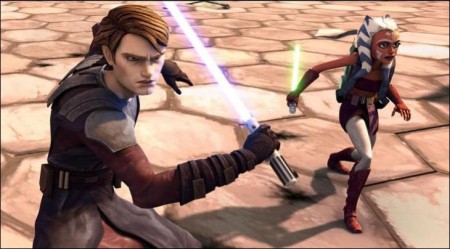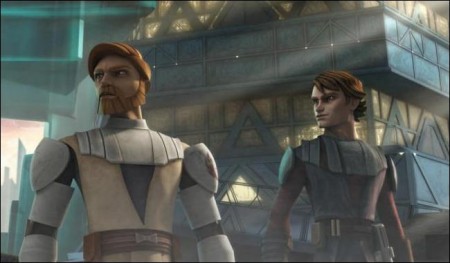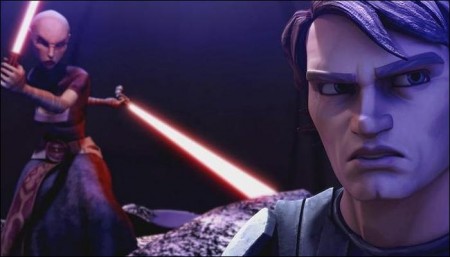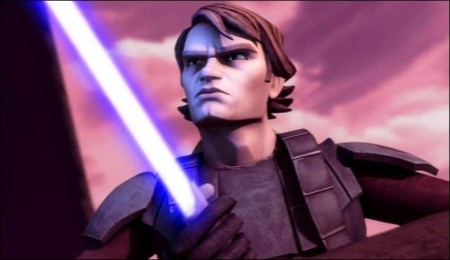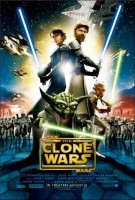As more star systems become swept up in the Clone Wars, the valiant Jedi Knights struggle to maintain order. Anakin Skywalker and his Padawan learner, Ahsoka Tano, embark on a fateful mission that brings them face-to-face with Jabba the Hutt. Plotting against them is the evil Count Dooku and his sinister agent, Asajj Ventress, who will stop at nothing to ensure the Jedis fail. Meanwhile, Yoda and Obi-Wan Kenobi lead the clone army against the forces of the Dark Side.
On the front lines of an intergalactic struggle between good and evil, fans young and old will join such favorite characters as Anakin Skywalker, Obi-Wan Kenobi and Padmé Amidala, along with brand-new heroes like Anakin’s padawan learner, Ahsoka. Sinister villains – led by Palpatine, Count Dooku and General Grievous – are poised to rule the galaxy.
Stakes are high, and the fate of the “Star Wars” universe rests in the hands of the daring Jedi Knights. Their exploits lead to the action-packed battles and astonishing new revelations that fill “Star Wars: The Clone Wars”.
First alluded to in 1977’s ‘Star Wars: Episode IV — A New Hope,’ the Clone Wars are a conflict between the Galactic Republic, led by the Jedi Knights and their clone army, and the nefarious separatist movement of Chancellor Palpatine (who later becomes the emperor). Not previously seen in any of the saga’s six films, the Clone Wars take place between the events of 2002’s Episode II and 2005’s Episode III.
About the Production
“Star Wars” takes on a dazzling new look in the first-ever animated feature from Lucasfilm Animation – “Star Wars: The Clone Wars”.
As the Clone Wars sweep through the galaxy, the heroic Jedi Knights struggle to maintain order and restore peace. More and more systems are falling prey to the forces of the dark side as the Galactic Republic slips further and further under the sway of the Separatists and their never-ending droid army.
Anakin Skywalker and his Padawan learner Ahsoka Tano find themselves on a mission with far-reaching consequences, one that brings them face-to-face with crime lord Jabba the Hutt. But Count Dooku and his sinister agents, including the nefarious Asajj Ventress, will stop at nothing to ensure that Anakin and Ahsoka fail at their quest. Meanwhile, on the front lines of the Clone Wars, Obi-Wan Kenobi and Master Yoda lead the massive clone army in a valiant effort to resist the forces of the dark side…
The voice cast features Matt Lanter as Anakin Skywalker; Ashley Eckstein as Ahsoka Tano; James Arnold Taylor as Obi-Wan Kenobi; Dee Bradley Baker as Captain Rex and the Clone Troopers; Tom Kane as Yoda; Nika Futterman as Asajj Ventress; Ian Abercrombie as Chancellor Palpatine; Anthony Daniels as C-3PO; Christopher Lee as Count Dooku; and Samuel L. Jackson as Mace Windu.
The Lucasfilm Ltd. production of “Star Wars: The Clone Wars” is directed by Dave Filoni; written by Henry Gilroy, Steven Melching and Scott Murphy; and produced by Catherine Winder. George Lucas serves as executive producer.
The movie features a score by Kevin Kiner, with original “Star Wars” themes and scores by John Williams. The creative team for “Star Wars: The Clone Wars” also includes editor Jason W.A. Tucker; supervising sound editor Matthew Wood; and animation directors Jesse Yeh and Kevin Jong. Gail Currey is the Lucasfilm Animation executive in charge of production.
Star Wars Returns to the Big Screen
In 2005, Star Wars: Episode IIII Revenge of the Sith brought the live-action, cinematic “Star Wars” Saga to a close. But creator George Lucas and the storytellers at Lucasfilm Animation had more stories to tell about the “galaxy far, far away.”
On-screen, the expansive, galaxy-changing Clone Wars was only fleetingly glimpsed in Revenge of the Sith and at the end of Episode II Attack of the Clones. But its importance to the “Star Wars” galaxy is enormous – causing the Republic to become an Empire, leading to the “period of civil war” famously mentioned at the opening of Episode IV A New Hope.
Since its first reference in a passing remark by Luke Skywalker to Obi-Wan Kenobi more than 30 years ago in the very first “Star Wars” movie, the subject has ignited the imaginations of moviegoers:
LUKE: You fought in the Clone Wars?
OBI-WAN: Yes. I was once a Jedi Knight, the same as your father.
LUKE: I wish I’d known him.
OBI-WAN: He was the best star pilot in the galaxy, and a cunning warrior. I understand that you’ve become quite a good pilot yourself. And he was a good friend.
“For years and years, people have wondered what the Clone Wars were, based solely on this quick mention,” says Clone Wars director Dave Filoni. “The live-action movies were really centered on the Skywalker family, and we’ve never gotten to see the full breadth of the conflict.”
Now, with the new animated feature, “Star Wars: The Clone Wars”, audiences will at last experience the galaxy-changing conflict, which simultaneously expands the scope of “Star Wars” beyond anything that had been seen in the previous films, and also introduces new characters, new dramas and new adventures.
The backdrop of the Clone Wars, Filoni says, offers a chance to tell the tale of a struggle that turned a Republic into an Empire and paved the way for a civil war that ultimately resulted in freedom for the galaxy. “We may be dealing with a small window of time, but the scope of war – particularly a galactic war – is pretty expansive,” he says. “There’s a lot going on – heroes, villains, intrigue, adventure. It’s all part of the story we know, but it’s always been in the background. Until now.”
One of the first steps in bringing “Star Wars: The Clone Wars” to the screen was finding the right entry point. The previous films had been confined to the Skywalker saga, but “The Clone Wars” offered nearly limitless options.
“A war, by nature, is a patchwork of untold stories,” says “Star Wars” creator George Lucas. “What’s fascinating to me is that there are people motivating these far-reaching events, and that those individuals are so often overshadowed by the big picture, by the events themselves. We know what happens to the galaxy, but we don’t know exactly how it all came to pass. These are the stories behind the story.”
Taking an entirely fresh approach to a film series that is forever imprinted on the minds of generations of fans, Lucas sought to create a distinct visual style that would evoke the spirit of the films, while at the same time bring a unique, distinctive look to the first animated “Star Wars” movie.
“We didn’t want it to look photo-realistic,” Lucas explains. “We were working with animation, and we wanted to really utilize the format. That meant shifting our thinking a bit. It’s a whole different way of telling stories, and it gives us the freedom to do things that just aren’t possible in live-action.”
While overseeing the project as executive producer, Lucas brought in Dave Filoni – a veteran of Avatar: The Last Airbender and numerous animation projects – to serve as director. With a deep-rooted fandom and a near-encyclopedic knowledge of the “Star Wars” universe, Filoni proved the perfect choice to take the reins.
“I’ve been dreaming about “Star Wars” since I was a kid, playing with the toys in the backyard with my brother,” Filoni notes. “Actually working on a “Star Wars” movie is beyond anything I could have imagined. It’s great to work in this world that I love so much, and to do it with George Lucas. Coming from a fan perspective, I also realize how important it is to do it right.”
With an entirely new story and a cast of characters that grows in significant ways, Filoni says “”Star Wars: The Clone Wars”” holds true to the films that came before it, while bringing a new sense of adventure and excitement to the “Star Wars” galaxy. “There’s one thing we knew we had to deliver above all else – a “Star Wars” movie,” Filoni says. “The characters are distinctly stylized, while their environments come to life in a much more realistic way, very much creating the kind of immersive worlds people expect to see in a “Star Wars” movie.”
What Are the Clone Wars?
“General Kenobi, years ago you served my father in the Clone Wars.” – Princess Leia, Star Wars: Episode IV A New Hope
For a thousand years, the Old Republic prospered and grew under the wise rule of the Senate and the protection of the Jedi Knights. But as often happens when wealth and power grow too fast and too far, greed-fueled evil soon took root.
Commercial interests became over-valued, the Senate became corrupt, and an ambitious politician named Palpatine was voted Supreme Chancellor. Most disturbingly, after a thousand years of seeming absence, a dangerous legion reappeared: the Dark Lords of the Sith.
Amid this turmoil, a Separatist movement was formed by Count Dooku, a charismatic former Jedi. He promised an alternative to the corruption and greed that were running rampant – and he persuaded thousands of worlds to secede from the Republic.
Unbeknownst to most of his followers, Dooku was himself a Dark Lord of the Sith, acting in collusion with his mysterious master, Darth Sidious. Over the years, Sidious had struck an unholy alliance with the greater forces of commerce and their private droid armies, which were unstoppable simply due to their sheer numbers.
Eventually, Count Dooku lured the unsuspecting Jedi into a trap on the desolate planet Geonosis. Little did the Separatists know, the Jedi had discovered their own secret weapon: a massive army of clones that the Republic had secretly commissioned years earlier. The Jedi won the battle of Geonosis – but the victory was short-lived. Instead of ensuring the Jedi’s power, Geonosis became the first battle in a massive war that spread like wildfire across the galaxy, engulfing thousands of different star systems.
It was the start of the Clone Wars. Now, the Jedi fight to maintain freedom and restore peace to the galaxy, using their army of clones against the massive droid army. Across hundreds of planets, the Jedi and Separatists fight for the future of the galaxy. As this terrible conflict grows ever wider, Anakin Skywalker, Obi-Wan Kenobi, Ahsoka Tano and Padmé Amidala are swept into the turmoil of war… while Count Dooku, Darth Sidious and Asajj Ventress stop at nothing to ensure the fall of the Republic. This is “”Star Wars: The Clone Wars””
Designing A New Galaxy
It’s Still Long Ago and Far, Far Away, But the World of “The Clone Wars” Is Unlike Anything That’s Come Before,
The “Star Wars” Saga introduced a galaxy that has become one of the most distinctive identifiable in movie history. Its iconic lightsabers, spaceships, costumes, droids and planets created a singular look that has endured through three decades and generations of fans. To translate the Star Wars aesthetic to an all-new format for “The Clone Wars”, the crews at Lucasfilm Animation faced a rare challenge.
“Our goal was to produce a movie unlike anything else in animation,” says “Star Wars: The Clone Wars” director Dave Filoni. “But we also had to stay true to star wars, to honor everything that George Lucas has created. That’s easier said than done, and it took us a long time to figure out exactly how to develop the look, style and feel of an animated star wars.”
It was Lucas himself who urged that “The Clone Wars” should forge its own distinctive visual style, separating itself from what had come before. Setting the story before Anakin’s descent into darkness, Lucas and Filoni felt animation could inject “The Clone Wars” with a rousing spirit of fun, highlighting the young Jedi’s heroism rather than his forbidding destiny. By visually distinguishing everything in its universe – from the battles to the characters themselves – “The Clone Wars” establishes itself as both a bold departure and a return to form for the Saga.
“George wanted the characters to live on their own, separate from the recognizable actors who portrayed them in the previous films,” says Filoni. “To do that, we really had to find the essence of the characters, and to bring them to life in a way that wasn’t just a reproduction of their live-action counterparts. We wanted to break free of any preconceived notions of what star wars should be.”
This meant eschewing photo-realism and embracing an entirely new look, different than almost anything else in cinematic animation. Of course, there were precedents for bringing the “galaxy far, far away” to the animated arena, including a 2004-2005 Cartoon Network “micro-series” about the Clone Wars period.
“We loved the look of the micro-series, and when we began to see the maquettes that were licensed on its behalf, it was a neat glimpse into what those designs might look like in a 3-D space,” says Catherine Winder, the film’s producer. “But we wanted to take it much further, to do something dramatically different with star wars and animation. Working in computer graphics, we incorporated those stylistic aspects into a world with an entirely different depth, physicality and scope. From there, it really began to grow and evolve into what’s on screen.”
The radical redesign involved a reinvention of the visual dynamic that fans have traditionally associated with the series. Drawing from a myriad of influences, Lucasfilm Animation experimented with an extreme shooting style, using aggressive lighting and framing to set the stage for the stylized new look of the characters themselves.
“I’ve always been a big fan of the anime look; Japanese animation and manga tend to push the envelope with really innovative composition, so we followed that lead,” says Filoni. “That said, animation is a vast field, and it’s too filled with possibilities for us to limit ourselves to one style. We also took inspiration from Gerry Anderson’s Thunderbirds, which was shot in the 1960s using marionettes. So we really took these disparate influences and fused them into something pretty unique.”
Filoni believes the creative risks that Lucasfilm Animation has taken, encouraged by executive producer Lucas, will please longtime fans and excite new ones. “In “”Star Wars: The Clone Wars””, we’ve got new characters, new planets, new vehicles, new battles and a new story, and it’s animated with a completely new style,” he says. “It really is Star Wars like you’ve never seen it before – in every way possible.”
Exploring the Galaxy
“The Clone Wars” Director Dave Filoni and Executive Producer George Lucas Discuss the Latest “Star Wars” Adventure
On Aug. 15, Lucasfilm Ltd. and Warner Bros. Pictures will release the first-ever animated “Star Wars” feature film – “Star Wars: The Clone Wars”. This expansive space adventure explores the galaxy-changing Clone Wars, a period of intense battle and grand adventure that takes place between “Star Wars”: Episode II Attack of the Clones and “Star Wars: Episode III Revenge of the Sith. In this interview, “Star Wars” creator George Lucas and “Clone Wars” director Dave Filoni discuss this groundbreaking new movie from Lucasfilm Animation.
How did the idea of an animated “Star Wars” movie come about?
George Lucas: The interesting thing about the Clone Wars is that in the normal course of the six “Star Wars” films that tell the Skywalker saga, that whole story of what happened during this time is not told – it’s skipped over. We have a little bit of the beginning in Episode II and a little bit of the end in Episode III. But, obviously, during a war there are lots and lots of stories – very exciting action, drama, heartbreak, even humor. The idea of doing an animated version of “The Clone Wars” was intriguing to me because it really allows us to tell other stories, show other Jedi, introduce new characters and even tell stories about the clones themselves. Some of them have very interesting stories. It allows us to broaden the canvas of what “Star Wars” is about.
Dave Filoni: One of the things that has always surprised me is how many stories there are to tell in what seems like a small amount of time. The period between Episodes II and III was only about three years. But we can tell so many new stories and meet new characters and go new places – places I never imagined we could.
What does animation bring to the “Star Wars” Saga?
George Lucas: Right from the very beginning, we knew we wanted to use CG animation in a way that hasn’t been seen before. We think we’ve ended up with something that is very new and different. Stylistically, a CG-animated film is quite different from a live-action movie. Animation opens up the possibilities of what you can accomplish. Animation is like a sketchpad.
Dave Filoni: There is infinite flexibility when we do a scene. We don’t have to go dig for original props or call actors back to reshoot. With animation, we can look at a scene in editorial, then go back and redo it completely differently the next day. That would be impossible in live-action. We have all of our sets, all of our actors at our disposal at all times. We can make things the way we’d like to see them, which is really exciting.
What can you tell us about the newest “Star Wars” heroine, Ahsoka?
George Lucas: Anakin and Obi-Wan have a great relationship, but we’ve seen their dynamic in the movies.
Dave Filoni: We always felt it was important to have a character whose temperament is somewhere between Anakin’s and Obi-Wan’s. Anakin will just jump in anywhere, while Obi-Wan wants to think things through before taking action. Ahsoka appreciates Anakin’s brashness but admires Obi-Wan’s patience and thoughtfulness. She has a lot to learn from both of them, but is strong and capable in her own right, so she sometimes surprises Anakin with her approach to the kinds of situations they find themselves in. She makes a great counterpoint to Anakin – visually, in her personality, her attitude. She sort of drives him crazy, but he grows very attached to her, as you’ll see in the movie.
George Lucas: In the “Star Wars” films, there’s a tradition of someone being taken on an amazing journey and learning to become a Jedi – Luke was a farm boy swept up in the Rebel Alliance. Anakin was a little boy on Tatooine. In “The Clone Wars”, Anakin is no longer a Padawan. He’s a Jedi. So Ahsoka takes on that role of the younger person who is being taught, who adds the dynamic that a “student” brings to the story. We bounced back and forth on a lot of ideas about her – would she be human or alien, male or female? We thought a girl would be just more fun to have in the story.
“The Clone Wars” gives you a great chance to explore characters outside of the Skywalker saga. Who are some of your favorites?
George Lucas: I’ve always liked Duros – the blue aliens from the cantina scene in A New Hope. They’re a derivation of Neimoidians – Neimoidians are greener. Wrinklier.
Dave Filoni: For me, it’s the Jedi Council. I love the opportunity to explore these characters we saw so briefly, but who are in their time legendary – Kit Fisto, Ki-Adi-Mundi, Luminara, Plo Koon …
George Lucas: If it were up to Dave, Plo Koon would be in every scene! It’s great that Dave’s got characters he really cares about, and who don’t have to just be in battles or short scenes or in the background somewhere.
Dave Filoni: That’s what’s really important. I care about these characters, and what happens to them, how they evolve in the film – that’s an adventure we’re really excited to show in the movie.
How would you describe the look of “The Clone Wars”?
George Lucas: In “The Clone Wars”, all of the characters and the environments look almost like they’re painted, which gives the movie a very distinctive look. We also drew some influences from manga and anime in our filmmaking style, which have very dramatic lighting and very aggressive framing.
Dave Filoni: “Star Wars” is already so brilliantly designed, if you look at the art direction of the feature films. It was important to maintain that integrity but give the audience something they haven’t seen before. The look is more stylized. It’s not concerned with photorealism; it’s more concerned with establishing its own visual reality, kind of in the same way a painter might use different techniques to create different looks. We’re using CG as a tool to create a stylized reality.
George Lucas: I think we’ve created some unusual, cinematic-style storytelling, something completely different from anything else in animation.
Production notes provided by Warner Bros. Pictures
Star Wars: The Clone Wars
Directed by: David Filoni
Starring: Matt Lanter, Ashley Eckstein, James Arnold Taylor, Dee Bradley Baker, Tom Kane, Catherine Taber
Screenplay by: Henry Gilroy
Release Date: August 15, 2008
MPAA Rating: PG for sci-fi action violence throughout, brief language and momentary smoking.
Studio: Warner Bros. Pictures
Box Office Totals
Domestic: $34,903,540 (52.8%)
Foreign: $31,200,000 (47.2%)
Total: $66.103,540 (Worldwide)
